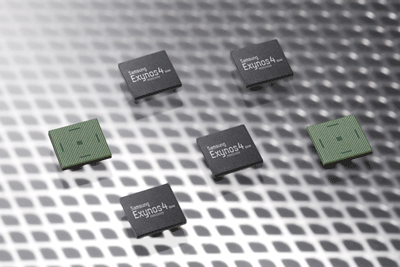Samsung announces details of new quad-core processor to be used in next Galaxy smartphone
Highly anticipated chip expected to take user experience to higher level
Samsung introduced the 1.4-GHz Exynos 4 Quad processor on Thursday, the chip that will be used to power the company’s next Galaxy smartphone.

Samsung’s Exynos 4 Quad processor (Via: bgr.com)
This tid-bit of teaser information comes one week prior to the company’s expected launch of its next flagship smartphone, supposedly named the Galaxy S III. A formal announcement of the launch is expected to take place on May 3 in London.
While Samsung has been coy about the name of their next phone, they did state outright that the ARM Cortex A9-based Exynos 4 Quad is already well into production and scheduled to be first designed into Samsung’s next Galaxy device.
So what does the processor have to offer?
Apparently, a lot. It’s well suited for heavy-load applications like 3D games, video editing, and calculation-intensive simulation. Also, according to the manufacturer, the chip has a video hardware codec engine for 1080p video recording and playback.
With so much capability, the obvious question turns to battery power. Samsung did address this during the chip’s design stages. Due to its low-power process and unique power-saving design, the Exynos 4 Quad actually “has two times the processing capability” of its dual-core predecessor “while consuming 20% less power,” according to Samsung.
So in short, it’s not just more efficient, it’s significantly more efficient.
“The quad-core processor offers phenomenal multitasking abilities surpassing any single or dual application processor. Since all the cores must share a single battery, the power management and efficiency in the limited battery capacity are indispensable for mobile computing devices,” says Taehoon Kim, vice president of System LSI marketing, Device Solutions, Samsung Electronics. “Given the diverse functionalities consumers are demanding from their mobile devices today, the Exynos 4 Quad meets those high-performance needs while keeping power consumption very low.”
To attain this high level of power efficiency, Samsung used hot-plug functionality to support on-off switching for the cores, as well as per-core dynamic voltage and frequency scaling. These design decisions offer a dramatic reduction in power consumption by adapting different levels of voltage and frequency when changing workloads.
What’s more, they were able to do this without affecting the chip’s size. Featuring identical form factor measurements (12 x 12 x 1.37 mm), the Exynos 4 Quad is pin-to-pin compatible with the 32-nm process-based Exynos 4 Dual. This allows mobile device designers to right away adopt the new chip without incurring additional cost, engineering, or design efforts.
The quad-core processor
A quad-core processor isn’t that much of a surprise — it’s the direction the industry’s been heading in for a couple of months now.
A multicore processor enhances the device’s performance and enables the user to accomplish more tasks in a shorter period of time. Good example: a user can stream a YouTube video on one core while the other cores update apps in the background, stay connected to Facebook, and scan virus-check simultaneously.
Want to learn more about quad-core processors? Check out our December 2011 story, On the Horizon: Quad-Core Phones.
Some other minor tidbits of information released about the new phone: it is expected to have a 4.6-in. display with a 1,280 x 720-pixel resolution; 8-Mpixel camera; and LTE connectivity (where available).
Via: Samsung.com
Advertisement
Learn more about Electronic Products Magazine





